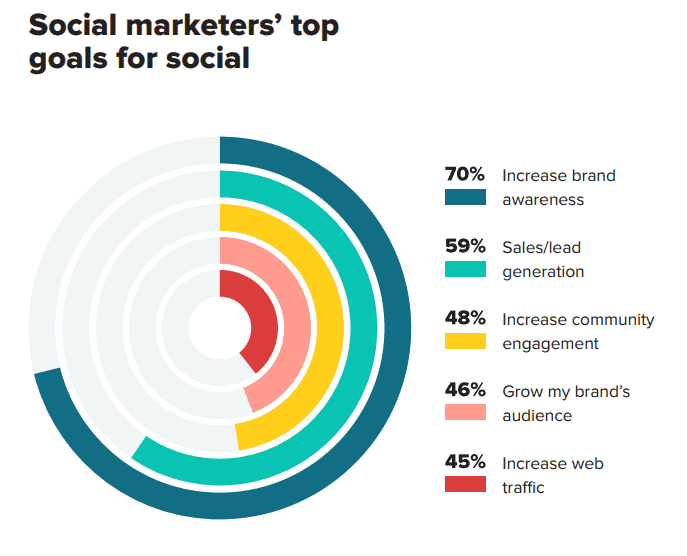In the modern education sector, businesses of all types compete heavily for new students and returning pupils. With the dawn of online learning and the proliferation of comprehensive, resource-rich digital education platforms, traditional education centers like schools and universities are no longer the leaders in the industry.
Nowadays, education opportunities are all around us, and traditional education is rapidly taking a backseat to eLearning, online universities, and digital training and learning platforms for businesses and individuals. No matter the sector or subject, you have ample opportunities to acquire that knowledge.
If you are a business leader in this sector, you know just how important it is to invest in social media marketing for education to develop your competitive edge and inspire people to enroll in your programs. That’s why today we will talk about one of the most important marketing channels, social media, and the strategies you need to implement right now to take your education business forward.
Here’s what you need to know.
Identify Your Social Media Goals

When setting goals and objectives and key results (OKRs) for your social media strategy, you must be precise and specific. It is easy to identify simple goals such as getting more people to sign up for your platform or enroll in your on-site classes, but those are business goals, not social media goals.
Your social media goals and OKRs serve to facilitate and support your business goals and long-term objectives. To better prepare your team for these challenges, consider utilizing resources like the Microsoft AZ-900 Practice Tests Dumps for enhanced skill development. Social media management and advertising requires setting complementary goals that will:
- Build brand awareness and reach
- Build brand authority and trust
- Build engagement and inspire brand-audience interaction
- Generate leads and promote your free content
- Drive traffic to your website and dedicated landing pages
- Grow your audience and tap into new audience pools
Your goals may be numerous and varied, but the end result is the same -to drive acquisition, retention, and brand reputation in a competitive industry. OKRs are those incremental goals and steps you take to achieve your larger goals. To achieve these goals efficiently, consider utilizing resources such as the Microsoft MS-600 Practice Test Dumps to bolster your team’s skill set.
OKRs need to be aligned between marketing, sales, and support departments to ensure all leads you generate on social media move efficiently through your sales funnel.
Nail Your Per-Platform Posting Strategy
Every social media platform is a separate, unique ecosystem that thrives on different conditions and different demands of consumers. There is no cookie-cutter solution for your overarching social strategy, because every platform demands a unique approach and has its best practices.
For example, have you noticed how the social media world has been buzzing lately about how pictures are dead on Instagram and now it’s all about the Reels? Deciding how to post to Instagram is the deciding factor between high engagement and a dead business account, and that posting strategy will differ greatly from Facebook, LinkedIn, or TikTok.
First, identify your most relevant social platforms so you can focus on the networks that matter to your audience. Once you have figured out where your potential students and customers reside online, you can optimize your per-platform posting strategy based on:
- The needs of your customers
- The type of content they prefer
- The time most of your customers are active
- The content requirements of each platform
- The posting frequency preferred by the platform (don’t get flagged as a spam account)
- The types of ads that generate interest
- The influencers you can work with
Once you have identified your ideal type of content and how and when to post it, move into asset management and scheduling to ensure high engagement for your education business.
Ensure Consistency Through Better Asset Management
![Social media marketing for education - Bulkly - 2 Social media marketing for education - [9 Strategies] Social Media Marketing for Education Businesses - 1](https://bulk.ly/wp-content/uploads/2022/10/word-image-24362-2.jpeg)
Social media asset management is all about utilizing your written, branded, and visual assets to their full extent in the oversaturated social media realm. To manage social media assets efficiently and effectively, create and employ various engaging assets to keep your feeds fresh and interesting; this strategy will ensure brand consistency and posting consistency across all your networks.
A unified brand image leads to a unified brand experience across your channels, something that modern customers want and expect from their favorite brands.
Remember, managing your social media assets in a consistent and unified manner generates more trust and better social proof around your brand, because you present a clear and trustworthy brand image.
To achieve this unified brand image, make sure to:
- Standardize your visual assets for quality and formatting for every platform
- Standardize your written assets for tone of voice, messaging, and brand personality
- Standardize your brand assets and ensure marketers follow your brand style guide
- Use an asset management platform to empower your creatives and social managers
Bring Visuals and Written Content Together on Pinterest
Most of the social media talk around the web revolves around platforms like Instagram and TikTok due to their sheer popularity, but there are some platforms out there with massive potential that rarely get featured in the spotlight. One of these platforms is Pinterest, which is a particularly powerful social platform in the education sector.
Pinterest is so powerful because it allows you to create inspiration boards on a variety of interesting topics surrounding not only your brand, but also your training modules and curriculums, numerous free resources, and content and blog. The more relevant boards you create, the more your brand will come up in searches and the easier it will be to get people interested and engaged.
Create a Pinterest marketing strategy that generates engagement on your boards and inspires shares; this strategy will also drive traffic to your website or even incentivize people to get in touch directly. Make sure to create a variety of pins for every board, including video, image, and idea pins to spark interest and interactions.
You can also advertise on Pinterest and create yet another effective way for people to get in touch.
Promote Your On-Site Perks and Amenities
![Social media marketing for education - Bulkly - 3 Social media marketing for education - [9 Strategies] Social Media Marketing for Education Businesses - 2](https://bulk.ly/wp-content/uploads/2022/10/word-image-24362-3.jpeg)
A big part of promoting your education business on social media is showcasing your physical place of business, your classrooms and community spaces, and all the perks and amenities you have on offer. For education institutions that offer on-site classes, workshops and training, this kind of promotion can make all the difference by creating a unique, competitive edge that strictly online businesses can’t match.
Why not flaunt what you’ve got? Create a series of engaging photo and video posts for different platforms showcasing everything from your branded school lockers that emphasize comfort and convenience, to your rich community and chill spaces and of course, your tech-driven classrooms. The emphasis here should be on the word “branded”, as you want to make sure that your unique brand identity permeates all of these visual materials.
Showcasing your brand’s benefits will make your brand more memorable and will resonate with your target demographic. Remember that people want to connect with a brand on a more personal level, so when showcasing your facility, emphasize your brand and its values as much as possible.
Use Gamification to Your Advantage
When it comes to social media content ideas that will get people to interact with you organically and generate qualified leads, there’s nothing quite like gamification. In the marketing education sector, you have a unique opportunity to create gamified content and incentives to tease your audience, appeal to the problem solvers among them, and engage those who yearn to learn something new and exciting.
Create social media quizzes or posts that lead to quizzes on dedicated landing pages on your site, and post interesting problems for your social media followers to solve. You can also set up a grading calculator to calculate their grades quickly, giving your content a unique, classroom feel. Based on their grades, recommend additional materials they can download from your website or ask them to enroll in your classes or eLearning courses.
The possibilities are endless; the crucial step is to follow up after they complete the test or the quiz.
Monitor Engagement and Key Performance Indicators
![Social media marketing for education - Bulkly - 4 Social media marketing for education - [9 Strategies] Social Media Marketing for Education Businesses - 3](https://bulk.ly/wp-content/uploads/2022/10/word-image-24362-4.png)
As with any other digital marketing tactic and method, it’s important to monitor your social media performance and how your content is performing in your saturated industry. Knowing how individual posts perform in a specific time period is just one of the KPIs you should follow in your social media analytics tool; you should also monitor interactions like shares and likes, conversations, and comments to gauge sentiment and filter out potential leads.
Your KPIs should include:
- Reach
- Audience growth rate
- Interest
- Interactions
- Shares
- Likes
- Comments
- Conversion rate
- Click-through to your site
- Bounce rate
- Cost per click
- Brand mentions and tags
- User-generated content
Monitor as many relevant KPIs as possible and visualize your data so you know where to optimize your approach.
Run Live Events Regularly to Deliver Valuable Information
Live events are an amazing opportunity for education businesses to showcase their worth and the individual talent and expertise of their staff. Featuring live Q&A sessions with expert math tutors can provide valuable content for your social media audience and showcase your educational expertise. Going live on various social channels regularly gives you the opportunity to not only communicate with your followers directly and engage with them in Q&As and meaningful conversations, but also to convey true educational value.
Social media is an effective way to communicate snippets of knowledge to your audience. The potential topic ideas are virtually endless! Choose from the wide array of potential topics at your fingertips based on the training curriculums you have on offer to share with your live audience.
Additionally, bring more value with live video interpreting for people with disabilities, as the importance of VRI in educational settings cannot be overstated. Keep your content fresh and interesting by bringing in experts from different fields to discuss these topics with you. Make sure to structure your live social events to allow enough time for questions and further discussions with your audience.
Align Social Ads with Audience-Specific Landing Pages
![Social media marketing for education - Bulkly - 5 Social media marketing for education - [9 Strategies] Social Media Marketing for Education Businesses - 4](https://bulk.ly/wp-content/uploads/2022/10/word-image-24362-5.jpeg)
Finally, keep in mind that education businesses should advertise on social platforms just like anyone else. Advertising ensures your brand reaches the right audience at the right time, increases awareness, and drives traffic to your website and dedicated landing pages.
Advertising is where your strategy on social media needs to get more granular. Investing in social media ads is not about promoting your brand and everything that you have on offer, it’s about targeting very specific customer groups with very specific content.
Align your advertising copy and visuals with specific target audiences. Make sure to remove the TikTok watermark and other platform-specific watermarks and replace them with your brand visuals. Consider all the types of students or online customers you’re trying to attract, and optimize the ads for what they want to learn.
Then, make sure your ads lead to optimized, dedicated, and highly-specific landing pages that give them all the information they need to make a positive decision. The more specific and granular you get with your ads and landing pages, the more relevant and compelling the messaging will be for your audience – helping them convert quickly.
Summing Up Social media marketing for education
Whether you’re a marketing strategist of a traditional education center or the leader of a digital eLearning platform, there’s no denying that you need to invest time and talent into social media marketing in 2023 and beyond. The education sector is becoming more saturated by the day, and given the fact that modern, potential pupils are spoiled for choice, you need to excel in your social media efforts to generate leads and inspire people to apply for your programs or use your education platform.
With these strategies and best practices, you have everything you need to take your social media marketing to the next level and achieve your short, mid, and even long-term goals.


